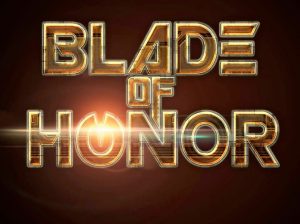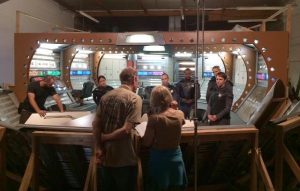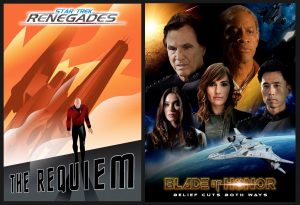 Last time: Ryan T. Husk, executive producer of the independent sci-fi series Blade of Honor, discussed the cast and crew of this exciting new project that’s currently raising money for its pilot episode (and possibly more episodes!) via Kickstarter. This web series features a number of Star Trek actors like Tim Russ, Aaron Eisenberg, and Cirroc Lofton, plus professional actors from other series, including Richard Hatch of Battlestar Galactica and James Kyson from Heroes. There’s also a bunch of veterans from Star Trek fan films like New Voyages and Horizon.
Last time: Ryan T. Husk, executive producer of the independent sci-fi series Blade of Honor, discussed the cast and crew of this exciting new project that’s currently raising money for its pilot episode (and possibly more episodes!) via Kickstarter. This web series features a number of Star Trek actors like Tim Russ, Aaron Eisenberg, and Cirroc Lofton, plus professional actors from other series, including Richard Hatch of Battlestar Galactica and James Kyson from Heroes. There’s also a bunch of veterans from Star Trek fan films like New Voyages and Horizon.
Ryan’s insights into to film industry have been fascinating, to say the least! As our interview concludes, we start off by discussing what differentiates an independent film from a fan film. And then we jump into how to set up and run a crowd-funding campaign…
JONATHAN: So, Ryan, are you from the camp that says anyone who works on a fan film has to be a volunteer and not get paid?

RYAN: Honestly, I don’t know the answer to that question. I don’t ever try to preach or really influence anybody’s thoughts. I just kind of absorb it and move on. But I would say this: there’s no way that you would get an actor who worked on Star Trek for seven years and has millions of dollars to work on your movie or short film or series for free. That just wouldn’t happen. So I think what the root of the question is: is a fan film something that has people in the industry or only people who are not in the industry? Because people who are in the industry like, for example, if we got Robert Beltran or Michael Dorn, would they work on something for free? No, they would not. So if you hire a professional actor or an industry professional, is it no longer considered a fan film? And I really don’t know the answer to that.
All I know is that it’s fun to do, and I volunteered endless hours to fan films, and I do it because I love it. Now, if I had ten million dollars and twenty million fans, would I work on something for free? Actually, I probably would! Now that I think about it, I would for Star Trek, but that’s because I’m a Star Trek nerd. If I didn’t like Star Trek, I probably wouldn’t. But I wouldn’t expect anyone else to. So after saying all of that, I don’t really have an opinion on whether or not people should get paid on fan films, I’m sorry to say.
JONATHAN: Oh, that’s okay. I’m in the process of writing a blog that’ll be called “What is a fan film?” and there’s a lot of opinions out there! The fact is that there’s no one, all-encompassing definition right now. And the question of whether fan films have to be all-volunteer or whether they can also pay people is not only unresolved at the moment; it’s actually rather hotly debated.
RYAN: I would say that there are two different questions in there. One is: what is a fan film? And I think the answer to that undeniably and inarguably is anything that is not licensed by the I.P. [intellectual property –Jonathan] holder. So anything that uses Star Trek and is not any of the Star Trek official series or any of the twelve-soon-to-be-thirteen official Star Trek movies, anything beyond that is a fan film…legally and completely and definitely.
I believe that the other question that is in there is: what should a fan film be, or what rules should it follow? And you’re right. From there it gets very gray and debatable. And in these changing times, it’s going to be debated more and more and more because technology is just improving our capacity to create things…with things like Kickstarter, with things like iPhone, with things like MacBook Pros, you can make movies. I mean, look at Tommy Kraft [creator of the fan film Star Trek: Horizon –Jonathan]. He can just make a frickin’ movie!
JONATHAN: So let’s shift our focus to your Kickstarter. I go to your campaign page, and I see that you’ve already produced a very impressive video with a lot of resources. I can see you’ve got costumes, you’ve got at least partial sets, you’ve got visual FX. And yet, you did this all BEFORE you even began your Kickstarter campaign. How much did all of this prep cost you, and who funded it so far?
RYAN: It was definitely over $10,000…although I don’t have any specific numbers with me right now. Probably much higher than that. The funding comes from the team of producers. Now, we make deals with people. There are a lot people who are willing to work in trade or more importantly for the opportunity to work on the bigger production once it is funded. So let’s say that, as an actor, I say I won’t work for anything less than $500 a day. And if somebody says, “Will you work for $100 a day or this thing? And then, if it gets funded and picked up by the TV show, then we can renegotiate.” And then that actor says, “Well, hell, yeah! Because if it gets picked up, it’s gonna have a huge budget, and I’m gonna become a star…or continue to be a star.” So it becomes much more affordable that way.
What really is the most expensive part is building sets, and you can do that with set-builders, too. Some people are willing to work for much less to create something that has a huge upside. I guess my answer is that we all kinda funded it in that way. Yes, money was brought in by the producers, and yes, the equivalent of money was created by the entire crew and cast…if that makes sense.
JONATHAN: How long has it taken you guys so far to get to the launch of your Kickstarter on May 11?
RYAN: We initially started our meetings and really moved forward with it at the beginning of last year. And so we started working on it and developing it. And Mark had a lot of series ideas that he wanted to work on, and we decided that Blade of Honor was the first one we should do…even though it’s probably the most expensive, being sci-fi, whereas things that are not sci-fi are usually cheaper. Actually, period pieces are really tough, and we do have a period piece—a French period piece, which’ll be really awesome to do because I’m French and I’m a Francophile.
When we decided to go ahead with Blade of Honor first, we got some of the cast and some of the crew—just the bare minimum—and we shot the proof-of-concept trailer maybe a year ago, maybe a little less than a year ago. We actually shot part of the trailer at Space Command Studios.

JONATHAN: I thought I recognized those hallways! I’ve seen them everywhere.
RYAN: Yeah, we love those guys at Space Command, and I act in it, and I’ve been a part of that team for a while.
So after shooting the raw footage, we edited, we got the social media going, and we were going to maybe launch our Kickstarter a few months later—at the end of the year or in autumn—but there were so many other Kickstarters going.
And that’s kinda the problem with crowd-funding is the timing of it all. Like, if you’re just getting outside funding, you work with what’s best for you. “When are you guys free? October? Great, let’s shoot it in October.” With crowd-funding, we had so many other Kickstarters and Indiegogos—there was Axanar, there was Renegades, there was Captain Pike—there were so many things going on at the end of last year, so we waited and we bided our time. And then Star Trek Continues just did theirs. And I really like spreading out the Kickstarters, and I always try to talk with all of my friends within the sci-fi and Star Trek community. And if you’ll notice, there are very few of the major ones going at the same time. And that’s by design. I don’t want to overwhelm the fans. I’m sure the discussion has come up about donor fatigue, and I think the best way to combat that is to have a coordinated effort, is for everybody to work together…yes, that means people have to act like adults and get along and be friends and say, “When are you doing your Kickstarter? March? Okay, well, we were gonna do ours in March, too. We’ll push ours to May, that way you can have yours, we can have ours, the fans can be happy, they don’t have to pick and choose.” Because if you’re directly competing with each other, maybe both projects don’t happen, and then who really loses? The fans lose.
The toughest part was finding when and where our good slot was. So that’s why it ended up being a fifteen-month journey instead of an eight or ten-month journey…because we waited and bided our time.
 JONATHAN: So you worked on Star Trek: Renegades, which is spending about $350,000 per episode at this point, and you’re asking for $30,000 per episode. Why is your project costing so much less?
JONATHAN: So you worked on Star Trek: Renegades, which is spending about $350,000 per episode at this point, and you’re asking for $30,000 per episode. Why is your project costing so much less?
RYAN: First of all, Renegades has much longer episodes. What we’re doing is webisodic. This is a web series. This is not a feature; this is not going to be 100 minutes or even 50 minutes like a Star Trek series. This is a smaller scale thing. JONATHAN: How long will an episode of yours be?
RYAN: I’m not really sure yet because it kinda depends on who we are pitching it to. They could be between 8 and 10 minutes, or other companies have expressed interest in the project—because we’ve been having meetings with a lot of these online streaming companies—they’ve been saying that what they like is 15 minute episodics. So in that case, our episodes might be more like 15 minutes. If we end up pitching it to a TV network, then you want it to be 42 minutes.
So what we’ve got is about 5 episodes for this first “season” that can either be 5 web series episodes—and we’re starting with this first one, and then once we hit that then the stretch goals will be episode 2, 3, 4, and so on—or they can be put together into a one-hour TV pilot. If you have a good story, good characters, good crew, and a good script, it’s really malleable. It could be broken up into parts or it could be a one-hour thing.
So to answer your question, it’s much shorter, so by definition, it’s gonna cost just a fraction of the price. That really shaves off about 80% of it of it right there—the amount of time that’s put into it. Also, I would say that Renegades has bigger costs in that it has more star actors, it’s gonna have more and bigger aliens. I know, because I’m working with it. It’s just a bigger production. Whereas Blade of Honor, we’re not skimping out on anything, but we’re really, really, really, shaving the costs. And the producers are eating a lot of the cost—that’s another big thing—in order to make this thing happen because the idea is that, in the long run, it’ll all pay off. So I suppose that’s the other part of the answer: $30,000 doesn’t cover everything, to put it bluntly! $30,000 does not get you an episode of science fiction unless it’s science fiction of people talking in the bedroom. (Laughs.)
JONATHAN: Most Kickstarters are either 30 days or 60 days long, and yours is 40 days. So what thought process went into picking that timeframe?
RYAN: Well, I’m a big Dungeons & Dragons nerd, so I rolled a 60-sided dice…
JONATHAN: I’m keeping that in the interview, dude!
RYAN: Yeah, go ahead, that’s funny. We were originally going to launch on May 4, but we pushed it back a week just because of Star Trek Continues, which was ending on the fourth, and we show a ton of support for them; they’re all our friends. And so we wanted to have a little spacing in between things. And then the end date…we don’t want to go 60 days; that just feels like too much. But we wanted to do a little bit more than a month so that we give fans a bit more time to settle in, relax, get to know the team, and donate.
So it was just kind of a round number, and we wanted to finish on a Tuesday. So we’re like, “Okay, there’s five weeks, but then we’ll do a few extra days for it to end on a Tuesday rather than ending at the end of a week or a weekend…”
JONATHAN: Why on a Tuesday?
RYAN: Well, we didn’t want to end on a weekend because people are out of town on weekends; they’re doing their own thing. And all crowd-funding campaigns get that big, final push on the last two days. And you’d be really hurting yourself by cutting into that big, final push if you ended on a weekend. Then ending on a Monday, you’re really losing out on that Sunday, as well. So we just pushed it to Tuesday. You just kinda go by feel.
 I mean, you want to start on a Wednesday; Wednesday’s a good day to start. That is known. Ending it, well, whatever you think is best. I haven’t really seen anything that suggests there is one day that is the best day to end a campaign. Just that there is one day that is best to start a campaign. So that’s what it was. We just wanted to do a little bit more than a month, so we did five weeks and we added a few days so that it wouldn’t end at the end of a week or on a weekend.JONATHAN: Why is Wednesday the perfect day to start on?
I mean, you want to start on a Wednesday; Wednesday’s a good day to start. That is known. Ending it, well, whatever you think is best. I haven’t really seen anything that suggests there is one day that is the best day to end a campaign. Just that there is one day that is best to start a campaign. So that’s what it was. We just wanted to do a little bit more than a month, so we did five weeks and we added a few days so that it wouldn’t end at the end of a week or on a weekend.JONATHAN: Why is Wednesday the perfect day to start on?
RYAN: Y’know, I don’t know! That’s just what the crowd-funding companies have said. We’ve heard that from numerous crowd-funding sources, the people that actually work at the companies like Kickstarter and others. If you’re doing a campaign, talk to their representatives. They will talk to you because the more money you make, the more money they make. They want to be successful, so they want you to be successful. So they’ll tell you. It’s no secret. Just ask, “When’s the best day to start?” They’ll say Wednesday…unless the data changes. But for the last couple of years, it’s been known that the best day to start is Wednesday.
JONATHAN: In the first 48 hours of your current Kickstarter, you got nearly half-way to your $30,000 goal (you had over $14,000 from 180 backers). How did you manage to take in so much so quickly?
RYAN: Marketing and amazing fans.
JONATHAN: How can you have amazing fan already if you haven’t made any episodes yet?
RYAN: Basically, what we’re talking about is fans of a concept more so than fans of a product…because there isn’t a product (unless you look at the trailer). But remember that we’ve been promoting this for over a year, so our fan base has grown because, if you just launch right away, nobody knows who you are.
So it was marketing for a year, and it was that a lot of the people who are involved have their own fan base. Tim Russ and the other Star Trek actors have their own fan base in the Star Trek community. Richard Hatch has his own fan base. James Kyson of Heroes has his own fan base. We have three actors from Star Trek: New Voyages that have their own fan base within the fan community.
I have my own fan base. I mean, I don’t consider them fans, I consider them friends because I can’t imagine I could ever repay the amount of support that they give me. But they’re really good people. And when I say, “Hey, check out this new project,” they immediately say, “Yes, yes, yes, I love it!” And I think more than anything it’s because they’re great people, and they’re great fans of Star Trek, and they’re great fans of science fiction. And we all know that Star Trek breed good, supportive people that have a sense of community.
JONATHAN: So what other marketing have you done?
RYAN: Most of it is promoting through social media. And the rest is word of mouth.
JONATHAN: Are you buying any ads on Facebook or anywhere?
RYAN: Not at the moment, but me might…because as I said, we’re “eating” a lot of money right now. Eating money to get more money in the long run is the only way it’s really worth it. So we may be doing Facebook ads later.
JONATHAN: And finally, what is your timeframe for production and the release of your episodes and of future Kickstarters?
RYAN: Ideally, we’d like to shoot in July-ish. And that’s what looks like the right time with our schedules. BUT! That’ll also depend on if we can get the stages in July, if we can get the sets built by July. So that’s our target area, July. But as with any production, once we get funded, we’ll find out if that’s actually feasible or if we’ll have to do it in August or September.
So we’re hoping to shoot this summer and be done by the end of the year!
JONATHAN: Well, best of luck to you and your team, Ryan. I can’t wait to see how Blade of Honor turns out.
RYAN: Thank you, Jonathan. It’s been a pleasure.
Note: Currently , Blade of Honor has a Kickstarter going with a goal of $30,000. Even though that number has already been reached, their first stretch goal is $58,000…which will allow them to make episode 2, as well. To find out more or to donate, click here. YOU’VE GOT UNTIL TUESDAY!


One thought on “BLADE OF HONOR (interview), part 3”
Comments are closed.